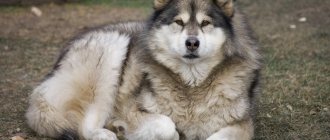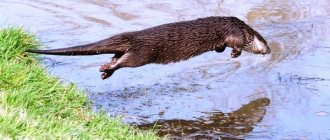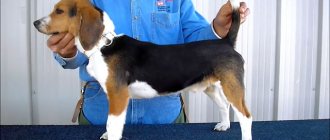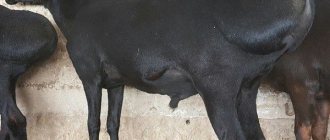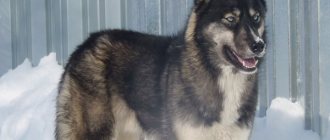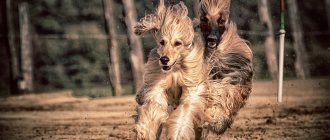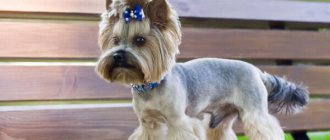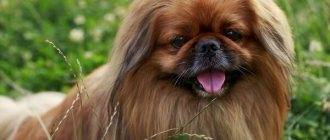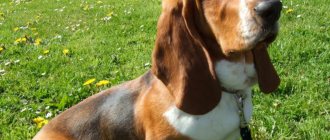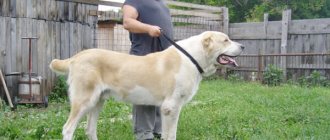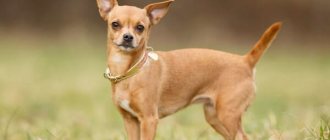Alabai is a guard dog, this is how it happened historically. It is believed that this breed appeared several thousand years ago from the mixing of nomadic herding dogs with Tibetan mastiffs and Mongolian shepherd dogs. The Alabai dog breed was used to guard herds, caravans and homes. This smart animal can become a loyal and devoted friend.
Alabai is a guard dog, it happened historically
Description
The Alabay (Central Asian Shepherd Dog) is a multi-purpose working dog native to Russia and the former Soviet republics of Central Asia. The breed is used for livestock protection, dog fighting, personal and property protection, and military work. The Central Asian Shepherd is one of the most popular breeds in the region of its origin. Alabai is a large and strong pet. It can not only survive, but also thrive in the harshest conditions found on Earth.
— Advertising —
The Alabai dog is shown in the photo.
Alabai with solid white color
Among connoisseurs of this breed, representatives with a solid, spotless snow-white color are very popular. Similar to Arctic polar bears, dogs with dazzling white fur are considered rare, so the cost of these puppies is slightly higher than those whose fur has spots and stripes of different colors.
Central Asian Shepherd white color
Appearance
The head is massive and wide. The forehead is flat. The nose is large, black or brown. The pet's jaws are powerful. There are 42 white teeth in the mouth.
The ears are triangular in shape and medium in size. Sometimes they are pruned if this is not prohibited in the country.
— Advertising —
Eyes: wide-set, round, dark in color.
The pet's body is powerful. The neck is short and muscular. The chest is large, the ribs are rounded. The loin is short, wide, slightly convex. The abdomen is moderately tucked. The back is strong, straight, wide.
The tail is thick at the base and set high. In a calm state, the tail is ring-shaped. In some individuals it is docked, unless this is prohibited in the country.
The coat is hard, straight and rough. The length depends on the type. Long-haired: 7 to 8 cm in length, short-haired: 3 to 5 cm in length. Under the fur there is a thick undercoat.
Alabai colors include the following: white, black, black and white, gray, straw, reddish brown, red, brindle, motley, spotted.
Pictures of black and white alabai are presented below.
The size of the Alabai dog is impressive.
Height: male 65-78 centimeters, female 60-69 centimeters.
Weight: male 50-79 kilograms, female 40-65 kilograms.
Alabai color options
Central Asian Shepherds are not only white or have black and white coats, as fans of these dogs believe. The color palette of purebred dogs is very diverse, including light beige, gray and red shades.
Alabai gray color
These proud, magnificent animals can be painted in a solid solid color or have an interesting original color, in which several colors are combined on their coats, creating a bizarre pattern of intertwined spots and stripes on the dogs' body.
Acceptable color options:
- white plain;
- white main with black, gray or red spots;
- black and white;
- black;
- all shades of red;
- grey;
- brindle;
- pale yellow.
Important: the breed standard does not allow silver-blue and chocolate coat colors in purebred Central Asian Shepherds, since dogs with this shade of fur are considered a cross between an Alabai and a Great Dane or a German Shepherd. But in America, representatives of this breed with a rich chocolate color are highly valued and such animals are purposefully used for breeding in order to consolidate the unique and unusual dark brown color.
Pros and cons of a dog
Characteristics of advantages:
- This is an extremely loyal pet.
- Alabai gets along well with people.
- The dog has excellent watchdog skills.
- Animals form deep bonds with their owners.
- The adult Alabai is an excellent defender.
- He is smart and confident.
- The dog gets along well with children if they are from his family.
- The animal is in good health.
- Caring for a pet is not difficult.
Characteristics of minuses:
- When you adopt a puppy, it is difficult to predict what kind of temperament it will have.
- He is distrustful and aggressive towards strangers.
- The Alabai dog has a strong-willed and independent character, so it is difficult to train him.
- Sheds heavily in spring and autumn.
- Often aggressive with other dogs.
- You need to constantly work with your dog.
- It requires a lot of space (both indoors and outdoors).
- The impressive size of the animal can be dangerous for small children.
- The dog is not hypoallergenic.
- The pet may bark at night.
Possible diseases and methods of treating them
The Central Asian Shepherd is one of the strongest breeds. She is muscular and resilient, beautiful and graceful. But even such a dog is prone to illness. The main problem of the Alabais is parasites. It’s hard not to “catch” them, especially if your pet spends a lot of time outside. Even if there are no fleas on his body, still give him medicine for these pests. It should be prescribed by a veterinarian who previously examined the dog. He will also calculate the dosage of the drug.
To prevent an animal from becoming infected with a dangerous disease, such as plague, it must be vaccinated in the first months of its life. The veterinarian informs the breeder about the vaccination plan.
History of the breed
The Alabai breed has an interesting history. These dogs were kept exclusively by nomadic herders who left few archaeological remains. Most of them were illiterate and therefore could not write about their dogs. The description of the Alabai dog indicates that the pet’s native region is Central Asia.
You need to understand how huge this region is. It includes: Turkmenistan, Uzbekistan, Tajikistan, Kazakhstan, Kyrgyzstan, areas surrounding the Caspian Sea and the Altai steppe. It is important to know the history of these places: the highlands of Tibet, Tien Shan, Pamir and the Great Steppe, through which tribes and peoples passed for centuries.
Numerous factors influenced the formation of the breed. Non-trivial conditions have formed many of its types. It is impossible to single out a specific subtype and claim that this is a real Alabai.
Due to the previously mentioned limitations, it is impossible to say with certainty when the Alabai breed developed. Even the earliest records of the region indicate the presence of these dogs. They have most likely existed for the past few thousand years.
There are two main groups of theories that try to explain the origin of the Central Asian Shepherd Dog. The first says that the Alabai descended from ancient Middle Eastern breeds that guarded livestock. The second says that the dog descended from the Tibetan mastiff.
The earliest dogs performed many roles in human society: they guarded homes, helped in hunting and herding livestock, were a source of meat and hides, and took part in battles.
Farmers of that time deliberately bred pets that had different, bright colors. This was necessary to distinguish our own from strangers, as well as from predators. To successfully fight wolves, dogs needed powerful jaws and fairly large heads. Farmers have also discovered that short, wide muzzles give their animals the largest possible bite area. The weather in those regions was harsh: cold winters, strong winds. Therefore, people tried to breed individuals with long hair.
The Central Asian Shepherd Dog also began to play an important social function in the region. Periodically, many tribes and clans gathered together. These meetings usually included religious and holiday festivals, political discussions, and so on. Tribesmen brought Alabais with them, especially males. The dogs confronted each other in dog fights. These fights were very different from the illegal fights that remain popular in the United States and the British Isles. Their point was not for dogs to fight to the death. In a confrontation they determined which animal was better.
Central Asia's harsh climate and landscape would likely make the region one of the most isolated places on Earth. However, it had a great location. Central Asia borders and lies between four of the world's most populous, wealthy and historically important regions: Europe, the Middle East, China and India. The famous Silk Road ran through Central Asia. To prevent theft, traders used Central Asian Shepherd Dogs to guard their caravans.
Dogs turned out to be so useful that they quickly spread throughout the world. Dogs were crossed with larger, longer, long-haired individuals, which led to the emergence of Spitz-type animals.
Existing data about the Alabai dog indicate that there are currently four main lines of the breed. Each has significant differences in temperament.
- Animals that are bred for conformation displays. They are the most controllable and least aggressive.
- Animals bred to protect livestock. They are usually subject to the highest demands on physical strength. These dogs demonstrate the most stable and predictable character. Although they tend to be more aggressive than show line dogs.
- Animals bred for dog fighting. They have the most unpredictable character and the highest level of aggression.
- Animals bred for military purposes. They are very aggressive towards people and work-oriented. However, this line is more predictable than the fighting line.
Alabai care and dog maintenance
When choosing a dog for yourself, be sure to think about what kind of life you are preparing for it. And after that, start calling breeders.
Large representatives of the breed require the owners of certain conditions for keeping the Central Asian Shepherd, diet, and sometimes the use of special feed additives that can slow down the early aging of joints
If all this is not a problem for you, you are not bothered by the short life expectancy and you are ready to spend any money on special food, then you can safely take a dog from a breeder who breeds “big dogs”. If it is important for you that the Alabai lives a long time, is unpretentious and does not get sick, then it is better to choose a puppy from parents whose size is closer to the standard indicators in the breed. Those who want a dog to successfully work as a guard and lead herds should choose a puppy from aboriginal parents and know that size is not important for work
The behavior of an Alabai largely depends on what kind of blood it is.
It is better not to keep an Alabai in an apartment; the best option for him is a country house, where it is recommended to build an enclosure with a booth for the dog. These two structures will allow your dog to have a roof over his head in rain or snow and will give you the opportunity to isolate the dog when visitors - be it construction workers, relatives or friends - come over. In areas with severe frosts, the floor of the enclosure is made of wood. In stone buildings, you can sprinkle hay, straw or sawdust on the floor. An enclosure for an Alabai should not become a place for its permanent detention.
The best option is free placement in the yard with access to all protected objects and a booth installed at a point that allows you to control the entire territory. Entrust the choice of location for the booth to the dog. It should have a view of the entrance and be located on an elevation. The flat roof of a low kennel will definitely be used by an Asian for a better view of the area, so place the kennel so that the dog cannot jump over the fence from it.
If you have two dogs of different genders, you will definitely notice a difference in their performance. Alabai male usually sits on an elevated place, vigilantly looking around the surroundings, while the female runs along the fence, monitoring the situation every minute. It is better if you plan the area in advance so that this dog behavior does not cause you any inconvenience.
When preparing for the appearance of a new dog in the yard, take into account one more feature of the Central Asian Shepherd breed. They love to dig holes. This is especially true for bitches, for whom such behavior is inherent in nature - in Central Asia, puppies are born in a hole carefully dug by their mother. By burying holes, you provoke the dog to look for another place. It is much more practical to choose one of them and let the dog rummage around there, taking all measures so that the second exit from the structure does not end up behind a fence.
The Alabai's fur sheds once a year in the spring. At this time, the dog needs to add special vitamins, eggs and elemental sulfur to the diet and comb it daily until the process is complete. Healthy Alabai wool has the ability to self-clean. Therefore, they often give themselves mud baths to escape the heat, old fur and parasites. Dogs rolled in mud dry out in the sun within an hour and their coat becomes shiny and clean.
Central Asian Shepherd Dogs tolerate any heat well in summer. Their Achilles heel is high humidity. In damp regions and during the rainy season, Asians may suffer from skin diseases, and they also commonly develop conjunctivitis. In winter, adult Alabai feel great outdoors, but require increased nutrition.
Kinds
Depending on the place of cultivation, several varieties of the breed have appeared. Below is a description of the different types of Alabais.
Caucasian
This is the rarest variety of Alabai dog breeds. It will be difficult to get puppies. The Caucasian Alabai is lighter and more resilient than, for example, the Turkmen species. But at the same time, individuals are much more aggressive than their Turkmen counterparts.
Main characteristics:
- The dog's weight is up to 75 kilograms, height is up to 70 centimeters.
- The Caucasian Alabai loves freedom very much.
- Dogs will not tolerate command over them except from their master.
- Pets have a lot of energy, so they need ample space for physical activity.
- The Caucasian dog Alabai is very smart. She can predict the enemy’s tactics, and then she will be the first to fearlessly attack him.
What Caucasian Alabais look like is shown in the video.
Turkmen
It is believed that this is the most ancient species that laid the foundation for the breed. His parent and predecessor is the Tibetan Mastiff. The Turkmen alabai is the largest of all varieties.
Main characteristics:
- The weight of the animal is up to 80 kilograms, height is up to 65 centimeters.
- The dog is used as a guard, not for fighting.
- The Turkmen Alabai dog gets along well with other animals, as long as it remains a leader.
- Personality Traits: Fierce, loyal, confident, balanced.
- It is best to avoid keeping these dogs with small children and the elderly.
- Turkmenistan has declared that the Turkmen Alabai breed is a national treasure. By law, pets cannot be taken out of the country.
Central Asian
The Central Asian or Asian Alabay is the most common species throughout the world. The breed was formed over a vast territory over more than four thousand years. It extends from the Caspian Sea to China, as well as from the Southern Urals to Afghanistan.
Main characteristics:
- The weight of the animal is up to 80 kilograms, height is up to 80 centimeters.
- The Central Asian Alabai is self-confident, balanced, calm, proud and independent.
- Asian Alabai are brave, hardy, have high performance and a natural instinct for protecting the territory.
- This breed is known for its fearlessness towards large predators.
- Although they are extremely affectionate and protective of their owners, these pets are not for beginners.
German
It is believed that the German Alabai descended from the “bronze dog”. She is a mixture of a wolf and an ordinary German dog. A characteristic feature of these individuals is a high degree of obedience.
Main characteristics:
- The weight of the animal is up to 80 kilograms, height is up to 65 centimeters.
- The breed was widely used in the army during World War II. Due to this, many animals died. But, starting in 1945, the variety began to be revived in Germany, the USA, Japan and the USSR.
- This is not a very aggressive species.
- Thanks to his internal instincts, the German Alabai perfectly senses danger.
- This is a hardworking animal. It is necessary to devote a lot of time to physical activity.
Siberian
For the first time, the Siberian Alabai was bred in the cold climate of Siberia. Due to the harsh conditions, the dog historically developed long hair and thick fur. It is believed that the Siberian Alabai is a cross between a German Shepherd and a Siberian Husky.
Main characteristics:
- The weight of the animal is up to 90 kilograms, height is up to 75 centimeters.
- The dog absorbed all the best qualities of his parents.
- The pet will listen to you unquestioningly and is easy to train.
- A good watchdog.
- The animal is smart, loyal, gets along well with people.
Types of Alabai dog breeds are presented in the photo.
Character
The character of the Alabai is considered to be balanced and calm; they are self-possessed, proud and independent. The dogs are very calm, rarely show aggression, and are not fussy.
They behave distrustfully and warily towards strangers. Dogs take life seriously and also have a slight arrogance.
Alabai recognizes as his owner only a strong, active person with a strong character and experience in dog breeding. This breed is not suitable for children and people who are sedentary, passive, or weak-willed.
Maintenance and care
Keeping and caring for animals will not cause you many difficulties.
The room where the dog lives must be kept clean. The floor should be mopped daily. Vacuum and wash the sleeping area every week. Do not allow your animal to sleep on upholstered furniture or mattresses.
The place where the pet sleeps should be away from windows and radiators. This is necessary to avoid drafts, hypothermia, and overheating. It is best to choose a quiet corner, away from doors and passages.
It is not recommended to keep the Central Asian Shepherd in an apartment. However, this recommendation cannot be considered a direct ban.
The animal must move a lot. In an apartment with a lot of furniture and fragile things, it will be too playful. Therefore, walk your pet 2 times a day.
No less important in caring for the breed is taking care of the coat. It is necessary to clean it daily with a special mitten or a brush with coarse bristles.
In addition, check and clean your pet's mouth, ears and eyes every day with a special cotton swab. Human ear sticks are not used to care for your dog's ears. They can easily cause injury, ultimately leading to deafness.
There is no need to wash the animal often. The procedure is carried out as needed, preferably no more than once a month. Use high quality grooming products. After bathing, the coat should be well dried to avoid hypothermia. This is especially important in the cold season. You can also use a hair dryer to dry it.
Walks and meals
If you need a dog to walk along the alley on a leash, then the Alabai is definitely not suitable. The physical characteristics of the dog require great stress. In order for him to grow strong, resilient and harmonious, he needs constant loads in the form of jogging, descents and ascents. For Alabais kept in an apartment and suffering from a lack of space and physical activity, many hours of double walks in the fresh air is a way out of the situation.
Both natural and factory-made food are acceptable for feeding the Central Asian Shepherd. If you prefer to feed your pet with ready-made food, then you should give only premium products. With a natural diet, you need to balance the supply of nutrients, so the diet should include lean meat, boiled sea fish, cereals, vegetables, some offal, kefir, and cottage cheese.
Nutrition
What are the breed's feeding requirements? Alabais are large animals that consume a lot of energy and need to be replenished. Therefore, feeding pets has its own characteristics.
Feed an adult pet 2 times a day. If your pet is highly active, add another meal during the day. Try to give food that is not too cold, but not too hot. Feed your dog about two hours before walking. After the meal, your pet should rest a little.
For the proper development of the body, the dog must receive proteins that cannot be replaced. The daily requirement for protein is about one hundred grams. High protein foods are meat, fish, and milk.
An adult dog should consume about 25 grams of fat per day. Without them, metabolism will be incorrect. The dog's body is not able to properly process vegetable fats, so give him fats of animal origin.
Alabai needs 350 grams of carbohydrates per day. They are a direct source of energy. Potatoes and various cereals are rich in carbohydrates.
The pet also needs elements such as calcium, magnesium, and potassium. Usually, they are contained in sufficient quantities in food. With a lack of micro- and macro-elements, serious diseases can occur. For example, brittle bones, nervous system disorders. To prevent such conditions, periodically give your dog meat and bone meal. Add 100-200 g to porridge or soup 2-3 times a week.
To ensure balanced nutrition and convenience, it is recommended to create a menu for the week. The main product for alabai is meat with a high calorie content. Make sure it is fresh, without signs of spoilage.
For feeding, lean meat is used - beef, lamb, horse meat. Alternatively, you can use jerky. At least once a week, animals should be given raw meat in small pieces.
You can sometimes feed your dog corned beef as a treat. Corned beef is a meat product that is obtained by aging raw meat in salt. However, it needs to be washed well and boiled before feeding your pet.
The daily intake of vegetables is 250-350 grams. Suitable for alabai are: cabbage, carrots, lettuce, beets, potatoes, spinach, young nettles.
To enrich the body with fats, periodically give your dogs fish oil.
You can also treat your dog to 300 grams of bread per day.
The animal should always have access to clean water.
Most Alabai owners are inclined to believe that dogs need to be fed natural food. But it is also possible to feed and switch to dry food. Such a decision must be thoughtful and balanced. Frequently changing natural food to dry food leads to problems with the stomach and intestines. In this case, you should consult a veterinarian.
Why doesn't he eat?
There are several reasons why your pet may refuse food:
- Change of food. Perhaps the dog doesn't like the new food and doesn't want to eat it. In the case of natural food, there may be an ingredient that is disgusting to the dog.
- Extra treats. Perhaps your animal is simply not hungry, as it constantly receives additional food between meals.
- Unusual food. Excessive amounts of salt or spices may cause you to refuse your usual food.
- Pain. It may be painful for your pet to eat. This can be caused by dental infections or toothache.
- Infections. For example, with ear infections, your dog may lose his appetite.
- Serious illnesses. Typically, they are accompanied by the following symptoms:
- Shiver.
- Hard breath.
- Decreased activity.
- The animal humps its back.
- The dog sleeps a lot.
You need to urgently contact a veterinarian to determine the cause.
Training
Training an Asian is an important stage in a dog’s adaptation to society.
Since Alabai is one of the few dog breeds that have a stubborn character, during the training process the main thing is not to give up and to carefully monitor the correct execution of commands. Otherwise, the dog will decide that it is okay to be disobedient.
- But the most important thing here is not to go too far and switch to a higher tone during training.
- You can start training as early as 2 months.
Advice: If punishment is necessary, you need to take the puppy by the withers, shake it quietly, and clearly say in a stern voice (not angry): “No” or “Ugh.”
Basic commands that a dog must understand:
- Lie;
- Place;
- Near;
- Sit;
- To me.
Learning commands should be gradual. This breed takes longer to learn commands than other dog breeds.
Girl
The girl's height is 60-69 centimeters, her weight is 40-65 kilograms
Sexual dimorphism in this breed is clearly visible. Alabai girls are usually smaller in size and not as strong.
There are also differences in temperament. Bitches are more resourceful and cunning. They also absorb material worse during training, unlike the opposite sex.
What do the puppies look like?
White Alabai puppies look quite powerful and bony.
They have strong and strong paws, a not too large head, a short body and a serious, but not evil look, characteristic of representatives of this breed .
Also, kids already have the makings of voluminous muscles. Their fur is not as coarse as that of adult dogs: it looks and feels like plush.
Nicknames for Alabai
The nickname Alabai is given once and for life. Before you name your pet, look at it carefully. Perhaps some character traits or color will help you choose the right name.
For boy
Popular boy nicknames with meaning:
- Aydin is the moon.
- Ayik is a bear.
- Aikol – noble.
- Darman is strength.
- Ailaker is dexterous.
- Jasur – brave.
- Kagysh - fight.
- Miyat is a protector.
- Palvon is a hero.
- Zangar is a giant;
- Kashan is beautiful.
- Sardar is a leader.
- Tupan is a hurricane.
- Nuker is a fighter.
- Enish - victory.
- Khaibat is a threat.
- Demir - iron.
- Kamal is a fortress.
- Yur is neat.
- Zangar is a giant.
- Kubat – strength.
- Derkan is correct.
- Kamtar is modest.
For girl
Popular nicknames for girls with meaning:
- Ai – moon, month.
- Aina – glass.
- Alada – care.
- Altyn-Gul is a golden flower.
- Orzu is a dream.
- Vepa – loyalty.
- Gala is a fortress.
- Nabira is a granddaughter.
- Kadama - armor.
- Paida - good.
- Kecha - night.
- Tara is the world.
- Tylla is gold.
- Kelin is the bride.
- Nezi – gentle.
- Shagga - quickly.
- Egna – needle.
- Vada is a promise.
Character and behavior
Of course, before you decide to get a dog of this breed, you need to read a lot of literature and talk with knowledgeable people. And it’s best if it’s a canine specialist. Answer the question: “Can I cope with such a big dog?”
The character of today's Asian Shepherd is not simple. And behavior often reflects how involved the dog's owner is in raising the dog.
- Alabai will not simply follow commands, he is too smart for that.
- First, the dog evaluates the need for the command, and then executes it (if necessary).
- The character is very strong, and you need to start raising an Asian as early as possible.
Advice: A dog of this breed should not be hit or scolded, otherwise it will be a disaster. It is best to use the services of a specialist.
Breeding
The female's pregnancy lasts 56-64 days. A week before the expected date, choose a place for birth. A pregnant Alabai bitch should get to know him.
It is advisable to prepare disposable diapers, cloths, medicines, a baby box, warm water and scales.
Signs of labor are as follows:
- The girl is losing hair in the nipple area.
- The pet became restless.
- Immediately before giving birth, the girl begins to experience intermittent breathing. One gets the feeling that the dog does not have enough air after running.
- A day before giving birth, a plug comes out (this is a blood clot that blocked the cervix).
Since Alabai are strong dogs, they usually give birth on their own. But still, you must control the situation and stock up on the veterinarian’s number in advance.
The bitch gives birth to 9 to 12 puppies. Their weight is 500-700 grams. Monitor your dog after birth. She can “torture” kids with her love.
Tiger alabai
These dogs have fur that is gray, brown or yellowish-golden in color. On the upper part of the body (back, neck, croup) and limbs there are dark transverse stripes that close into rings in the chest and abdomen. In some individuals, the main coat color is diluted with white spots.
Many brindle-colored dogs have dark, almost black fur on their faces, which makes it appear as if the dog is wearing a mask.
Alabai brindle color
Puppies
Before purchasing Alabai puppies, weigh the pros and cons. But if you decide to make such a friend, there are several rules when purchasing.
- Don't buy from poultry markets. If you want a mentally and physically healthy dog, choose your breeder carefully.
- Before purchasing, carefully study photographs of puppies of this breed. You should know well what an Alabai puppy looks like: height and size, coat color, habits, and so on.
- Pay attention to your parents, they must be in good health.
- Take a puppy that is 2 months old.
- Choose a curious, not shy baby.
- The Alabai puppy should be energetic, healthy, with straight legs, clean coat, eyes, ears and a wet nose.
The average price for a small Alabai from a regular breeder is about $500-700.
If you want to buy a premium puppy, you will have to pay around $1,500.
What does a puppy look like before 12 months of age? The average data is shown below.
| Age, months | Weight, kg | Height, cm |
| 1 | 3-5 | 25-30 |
| 2 | 9-10 | 35-40 |
| 3 | 12-18 | 40-45 |
| 4 | 20-30 | 50-55 |
| 5 | 32-37 | 55-58 |
| 6-8 | 36-50 | 60-65 |
| 9-10 | 60-70 | 75-80 |
| 11-12 | up to 80 | up to 80 |
What to feed an Alabai puppy? Regardless of type and weight, your puppy's food should be well-balanced and rich in protein, vitamins, minerals and other essential ingredients.
Here are the essential nutrients your new friend needs daily:
- Proteins for the development of tissues, organs, muscles. They help prevent diseases. Proteins should be of high quality and make up more than 25% of the diet.
- Glucides also make a significant contribution to the healthy growth of your pet. They are mainly found in cereals.
- Essential fatty acids are important for the development of the nervous and immune systems. They are easily digestible and provide the body with vitamins and energy. They are found in meat.
- Calcium is necessary for proper bone development. It is found in milk and cottage cheese.
Feed puppies at the same time and in strict portions. Give your pet as much as he can eat at one time. Food should not be in the bowl all the time. The diet consists of meat products, cereals, fresh vegetables and herbs. Dry food is not recommended for a puppy. Eating too much liquid food can lead to intestinal twisting.
Babies should not be overfed, even if they ask for more. This not only threatens excess weight and stress on the bones, but also leads to stretching of the stomach.
How many times a day should you feed the baby?
| Age | Number of meals |
| From 1 to 3 months | 5 times a day |
| 4 to 5 months | 4 times a day |
| From 5 to 8 months | 3 times a day |
| From 8 months | 2 or 3 times a day, depending on activity |
New products are introduced gradually and in small portions. If an allergic reaction is detected, the product is excluded. It is recommended to give your puppy a raw chicken egg 2 times a week. It is useful to give the shells, previously crushed in a coffee grinder.
Several times a week, meat products are replaced with boneless fish. Give your animal pig ears, cheeks, hooves, and beef bones as a treat 2 times a week.
Photos of popular species and their descriptions
Alabai is a common dog breed, especially in Asian countries. And each of them has its own vision of the ideal representative of this breed. Additionally, the appearance of each breed variety varies depending on its natural habitat.
Tibetan
The Tibetan Alabai is a large, shaggy and muscular dog with harmonious proportions and a moderately elongated body. Males grow to at least 70 cm at the withers with a body weight of 50 kg, females are 65 cm tall and weigh 40 kg.
Turkmen
They are considered the descendants of Tibetan mastiffs, which, after entering Central Asia, began to acquire features characteristic of modern Alabai.
These are guard dogs, not fighting dogs, but they can fend for themselves and protect their owner. They have a tendency to dominate and can get along with other animals only if they recognize their leadership qualities.
Turkmen Alabai are fierce and independent, but also loyal, self-confident and have a balanced character and stable psyche.
Caucasian Shepherd Dog
Caucasian Shepherd Dogs are freedom-loving animals that will not obey anyone except their owner, in whom they will see the leader and leader.
Due to their high degree of aggressiveness, such dogs must be kept with the utmost care.
Turkish Kangal
Representatives of the Turkish Kangal breed have been used since ancient times as fighting dogs, protectors and hunters.
These are obedient dogs, distinguished by speed, courage, endurance, vigilance, distrust and the ability to make decisions independently, assessing the situation. They are kind and flexible and get along well with other animals.
Height at the withers reaches 70-80 cm, weight – 55-65 kg. The coat can be gray-yellow or gray-brown.
Kyrgyz wolfhound (debit)
The breed is on the verge of extinction.
These wolfhounds were used primarily for herding. These are large, powerful animals with thick and straight hair; they can be either short- or long-haired. They have a calm character and are obedient. They grow up to 70-76 cm at the withers and weigh 40-70 kg.
Uzbek buribasar
Compared to other varieties of Alabai, the Uzbek Buribasar has a miniature stature, an elongated body and an elongated muzzle.
Smart, flexible, reserved dogs.
Kazakh tobet
Strong, hardy, large animals, reaching a height of 77 cm and a weight of about 45-65 kg. The coat is coarse and thick, piebald or spotted color is acceptable. They get along well with other animals and have a good guard instinct.
At the moment, the species is on the verge of extinction.
Siberian
The Siberian Alabai is a cross between a German Shepherd and a Siberian Husky. A large dog with thick fur. Characterized by a high level of intelligence, sociability, obedience and developed security and protective instincts.
Tajik
These dogs are larger than the Turkmen Alabay, have a heavier shape and resemble St. Bernards. Good-natured and reserved animals, good shepherds and loyal friends.
Malamutes are friendly, intelligent, but sometimes overly stubborn dogs.
Armenian (Gampr)
These are viable, independent, self-sufficient dogs with short or long coats. Height is 65-78 cm, weight is approximately 60 kg.
Alabai from Afghanistan
One of the oldest dogs with a refined body, up to 75 cm tall and weighing 30-45 kg. Wool can be black, white, red, blue and other colors. Willful animals with a tendency to dominate.
Dog character
Central Asian Shepherds are famous for their loyalty and courage. They are highly valued in their native lands for their protective abilities. Dogs are loyal to their families and will protect them without hesitation under any threat.
Such animals are not the best choice for first-time owners. This is because dogs are difficult to train due to their size and temperament.
Alabai must be taught his place in the family. It is important for the dog to know who is the “alpha male” in the family. Otherwise, they may start to show their dominant side. This causes the pets to become unmanageable and therefore more difficult to handle. Early socialization of the animal is important. Their training should begin at a young age. Once the puppy arrives at its new home, you should set some ground rules.
With that said, specimens are a good choice for people who are familiar with their needs. Also, dogs are suitable for families with children.
Pets create strong bonds with babies. Subsequently, when the children grow up, the connection will not decrease. They will always protect their friend.
Animals don't like to be left alone. A long separation from all family members can lead to destructive activities in the home.
Dogs are also known to be a bit aloof and wary of strangers. It should be noted that the Central Asian Shepherd rarely exhibits any aggressive behavior towards those it does not know. She prefers to just keep her distance. But the animal will not allow a stranger into its territory while the owner is not nearby.
Dogs are very smart. They are able to make the right decisions and take action. It is for these qualities that they are valued in their native regions.
There is also evidence that individuals are used as therapy dogs.
If an Alabai is introduced to other dogs at an early age, they will get along well throughout their lives. Shepherds are also tolerant of other animals with whom they grew up in the household.
Dogs will happily chase the neighbor's cat on their territory.
Character traits
White Alabais are majestic and calm, they have a balanced temperament and a strong character . They are smart and easy to train.
But due to their freedom-loving nature, these dogs can become stubborn and disobedient. The main difficulty in raising them is that the Alabai are not characterized by impeccable obedience and the fact that they do not tolerate coercion or the influence of forceful methods.
They are devoted to their owners and behave calmly and confidently in the family . They treat other pets well, but serious conflicts are possible with other people's dogs.
Alabai treat children quite kindly and even patronizingly. Perfectly aware of their strength and power, these dogs take care of the kids and look after them in their own way.
Alabais by nature have strong protective and watchdog instincts, therefore, they guard their territory with special zeal..
Training
Training a Central Asian Shepherd can be downright unpleasant. This pet's high IQ is accompanied by stubbornness that is difficult to break. The key to the solution is your establishment of a leadership role and early socialization of the animal.
This is a smart, brave, independent dog that is used to dominating. Therefore, owners must be stronger and more consistent in training. If you do not have training experience, you should not take such a large and stubborn pet. When you clearly decide with the Alabai that you are a leader, training and socialization will go better. Be firm, patient and don't be harsh. On the contrary, praise and reward your shepherd when he obeys.
The ability to think for themselves was important when dogs had to survive in the cold mountains of Central Asia. Therefore, dogs are undoubtedly smart and resourceful. A talented trainer will be able to use this trait to their advantage rather than allowing the animal to manipulate the situation and get its way.
Early socialization and training are important for this breed. This is due to the fact that aggression and physical strength are easier to overcome at a young age. Start training your puppy as soon as you take the puppy into your home.
Exposing your baby to different situations, people, places, sounds and animals is important.
Description of an adult and a small shepherd
Male
Externally, males always look more massive and courageous. Their withers are more muscular and more clearly defined.
In addition, males are distinguished by their calm behavior. They like to be on a hill from where they can look around the surrounding area.
Bitch
Females are most often smaller and lighter than males . They have a longer body and a smaller head. Bitches prefer to control the situation, constantly inspecting the entire perimeter of their territory.
Puppy
The puppy grows up quite quickly, and by the age of 9 months it has the characteristics of an adult dog. Growth continues after the 9th month of life, and ends only by two to three years. All this time, the puppy continues to build muscle mass.
Diseases
It is almost impossible to make any generalizations about the health of this species. Breeders claim that these are some of the healthiest individuals of all large breeds. The health of the Central Asian Shepherd is connected with its history. Dogs lived in some of the harshest conditions on Earth. At the same time, they fought against dangerous predators. Only the strongest could survive, and any genetic defects would be quickly eliminated.
However, those pets that have recently been crossed with other species may be susceptible to genetic diseases of those breeds.
The animal is known to have skeletal and visual problems. Therefore, owners are strongly advised to have new family members checked by veterinarians immediately. They will conduct genetic and other tests to identify potential health defects. This is especially valuable for conditions that appear in old age.
Large Alabai dogs are prone to the following problems:
- Hip dysplasia.
- Elbow dysplasia.
- Skeletal growth disorders.
- Heart failure.
- Heart problems.
- Problems with the spine.
- Arthritis.
- Bloating/Gastric Torsion.
- Progressive retinal atrophy.
- Cataract.
- Glaucoma.
- Heat intolerance.
- Deafness.
- Infections and parasites.
- Obesity.
- Dental problems.
Here is a detailed description of several serious diseases.
Hip dysplasia.
Hip dysplasia is one of the most common serious inherited diseases in domestic dogs. It is caused by a malformation of the above-mentioned joint.
Where the upper leg bone meets the femur, an “acetabulum” is created, shaped like a rounded, concave socket. In a healthy dog, the head of the femur, or kaput, fits almost perfectly into the acetabulum. Both are covered with a protective layer of cartilage. This cartilage prevents the two bones from rubbing directly against each other. The cause of the disease is a problem with the shape of the femur, the shape of the acetabulum, the cartilage between them, or perhaps some combination of these. Symptoms: lameness in the legs, the animal has difficulty standing up. Seek help from a specialist.
Bloating/Gastric Torsion.
Gastric torsion, more commonly known as bloat, is one of the most serious health problems in pet dogs. Without timely medical care, it usually leads to death. The death of a dog can happen in just one day!
In this condition, food and gas cannot leave the stomach. This promotes their accumulation, which increases bloating. As more and more food and bubbles become trapped, the stomach swells and expands.
The main symptoms: a sharp increase in the dog’s tummy, malaise, heavy breathing, vomiting with foam, pallor of the mucous membranes. Contact your veterinarian immediately.
Progressive retinal atrophy.
Progressive retinal atrophy is one of the most common genetically inherited conditions found in domestic dogs. This is the main cause of blindness in your pets.
The retina is located at the very back of the eye. It is responsible for collecting visual images and transmitting them to the brain through the optic nerve. The retina is divided into the inner or neural retina and the outer retina or retinal pigmented epithelium. The inner retina is further divided into nine layers, the outermost of which contains photoreceptor cells. They are usually called sticks.
The rods function in low light and detect shapes and movement. In animals with progressive retinal atrophy, rod cells are gradually destroyed. This happens until the dog becomes completely blind. The disease almost always affects both eyes equally, leaving the dog completely blind at one point. Symptoms: Your pet has decreased vision in low light or at dusk. For treatment, contact your veterinarian.
Glaucoma.
Glaucoma is an imbalance of fluid pressure in the eye. There is a fluid inside the eye called aqueous humor. Its composition is completely different from tears. Water humor is responsible for maintaining the correct shape and pressure inside the eye. It is constantly produced by the body, a process sometimes called "the tap." To maintain proper pressure, fluid must be drained regularly from the eye into the bloodstream. Water humor flows out of the eye through a mesh-like structure known as the drainage angle or "drain".
Glaucoma occurs when there is some problem with the drainage angle that prevents the proper release of aqueous humor. Water humor begins to fill the eye, causing it to expand like a balloon. As a result, intraocular pressure increases sharply.
Glaucoma varies greatly in severity and rate of occurrence. In some dogs, glaucoma worsens over weeks or months. For others, the condition results in permanent blindness over a period of days or even hours. Symptoms: watery eyes, constantly dilated pupil, swollen cornea, you notice that the animal sees worse. Contact your veterinarian for help.
Health and common diseases
Central Asian Shepherd Dogs are distinguished by good health, and they have virtually no hereditary diseases. Average life expectancy is 12-15 years. For non-purebred and improved, refined individuals, the age limit does not exceed 10 years.
In the first three months, Alabai puppies are reliably protected by the mother’s immune system. Upon reaching the age of three months, their body becomes vulnerable to viral diseases, and since Central Asian Shepherds reach full maturity only by 2-3 years, the pet’s health should be closely monitored. Vaccinations are carried out strictly according to the schedule, and in addition to the mandatory vaccinations (rabies, viral hepatitis, leptospirosis, etc.), additional ones are recommended for Alabai - against parainfluenza, piroplasmosis, infectious tracheobronchitis.
Like all large dogs, the most vulnerable point in Alabais is the musculoskeletal system. Hip or elbow dysplasia can be either congenital or acquired. In adult dogs, especially those living in city apartments, it develops due to obesity and lack of physical activity. Other diseases of bones and joints that are diagnosed in Central Asian Shepherds include arthrosis, arthritis, and myositis.
When keeping Alabai, you need to take into account that they are prone to overeating, which means increased weight gain, which is extremely undesirable. Obesity not only increases the load on the joints, but also provokes cardiac arrhythmia and myocardial infarction.
Hereditary pathologies inherent in Alabai include:
- hypothyroidism - dysfunction of the thyroid gland;
- addition deformation;
- lack of teeth;
- glaucoma, cataract.
Bitches are often diagnosed with cryptorchidism - the absence of sexual heat. The heat begins according to the standard pattern, but the female does not allow the male to approach her. If the pathology is not recognized in time and sterilization is not carried out, then the dog may develop purulent inflammation of the uterus (pyometra). This is a very dangerous disease that, if left untreated, leads to the death of the animal.
The best Bengal cat in Moscow
Why are ears cropped?
Cropping of an animal's ears is done for the following reasons:
- Aesthetic purpose.
- Therapeutic purpose.
In ancient times, the ears and tails of pets were constantly trimmed. This was due to their purpose. The fact is that they could interfere in fights with predators and other dogs.
Nowadays, each breeder and owner chooses what to do. Some people think that Alabai does not look like himself with big ears and a tail. Others are of the opinion that docking is an outdated method that only causes pain to the animal.
Education and training
Raising and training such a strong animal is simply necessary. You need to start training at a young age, from three months. You need to practice alabai for at least 30 minutes a day. By the age of five months, he should know such simple commands as “Come to me!”, “Sit!”, “Place!”, “Ugh!”
It is worth remembering that Alabai is capricious and is unlikely to obey you right away. Only patience will help you achieve results. You can encourage your great friend with treats and friendly stroking on the back of the neck. All this will become incentives for the dog.
Males are easier to train than females. It is better to entrust the training of a peculiar shepherd to a professional. Only they are able to turn a puppy into a guard and well-mannered dog.
Alabai puppy
Dream Interpretation
Many people are interested in: why do you dream about Alabai? In general, the dog has always been considered a symbol of friendship and loyalty. A dream with alabai portends news from your friend.
The color of the pet also matters:
- Black: Beware of your friend. Perhaps he is planning something against you.
- White color: Be confident in your close friend.
- Red color: means your boyfriend, husband or wife.
Remember the behavior of Alabai in a dream. The dog grins at you - beware of your friend. You are running away from an animal - beware of the pitfalls in life. You play with your pet - good news awaits you. A dog that barks, growls, attacks - scandals and insults will soon await you.
Red alabai
The red color of Central Asian Shepherds has many variations and shades. There are individuals with yellow-golden, light beige, reddish-red or copper-brown fur. The red color may be solid or mixed with white markings on the chest, belly, paws and face.
Alabai light red color
Representatives of this breed are especially beautiful, having the so-called wolf color. The main color of the animals' fur is bright red or with a gray-brownish tint, the belly, neck and chest are white, and the lower part of the forehead, cheeks and the area around the eyes are painted black or dark gray.
Alabai dark red color
Interesting Facts
- Alabais are the eighth largest dogs in the world.
- The record holder for size is an animal named Bulldozer. The largest Alabai in the world lives in Russia. The weight of the largest dog reaches 125 kilograms.
- The word alabai means “motley” or pockmarked.”
- As a protest, the pet may relieve itself in the most unexpected place.
- In some countries it is prohibited to keep the breed, as it is considered aggressive.
- You can see Alabai in such films as “Makar the Pathfinder”, “Boatswain”, “Okhlamon”.
- The Uzbeks call the dogs Buribassars, which literally means “wolfhound.”
- Many people wonder: why does the little Alabai bite? This is due to his built-in hunting instincts. You need to explain to your pet in time that you shouldn’t do this.
- Is Alabai dangerous for humans? Of course, if you are a stranger who has entered his territory.
- There is a variety of the breed called the Turkish Alabai Kangal. According to the myth, the dog was given to the Ottoman padishah. He was delighted with the strength of the dog, which was able to kill the lion. The photo shows a Turkish Alabai dog.
Central Asian Shepherd - general features of the breed
In accordance with the standard, the breed has the following characteristics:
- The height at the withers is at least 70 cm for a male and at least 65 cm for a female.
- Weight - from 45 to 80 kg.
- Wide and massive head with a flat forehead.
- The brow ridges are well defined.
- The eyes are round, dark in color.
- Triangular small ears, often cropped to standard.
- The nose is large, brown or black.
- Powerful body with a short neck.
- The croup is wide, almost horizontal.
- The coat is straight and hard, and can be either long or short.
- Characterized by a wide chest with rounded ribs and a tucked belly.
- Strong paws and limbs.
- The tail is saber-shaped, often docked according to the standard.
- Color can be black, white, brown, red, gray, speckled and fawn.
Mating
To get high-quality offspring, it is important to know some aspects of mating Alabais.
- The female matures at one year of age, the male at 16 months.
- Estrus occurs 1-2 times a year. More often in the spring.
- It is necessary to pair a female with a male only on the 3rd heat. By this time, the dog will be fully strengthened and ready to give birth to healthy offspring.
- Males can be taken for mating from the age of 2 years.
- Early mating has a very bad effect on the dog's health.
- Estrus lasts approximately 25 days. Mating is carried out 8-12 days after the start of estrus.
- Before mating, the animals must be introduced. It is better in the territory of the male, but in her territory the female may turn out to be aggressive.
- The mating process is repeated after 2 days.
- In a litter, as a rule, there are up to 10 puppies.
How much does it cost and how to choose a puppy?
It is best to choose an Alabai puppy from nurseries or professional breeders; when purchasing, you should consider the following points:
- the baby must be active, with shiny fur, clean ears, a wet nose, moderately well-fed, at least two months old, corresponding to the breed standard in appearance;
- there should be no more than five puppies in the litter and their mother should be no older than 8 years;
- availability of all required documents and vaccinations.
The price of Central Asian Shepherd puppies varies greatly. You can buy a puppy for 3-5 thousand rubles. from owners who do this unprofessionally, but you can pay from 15 to 40 thousand rubles. and more for a purebred puppy with a pedigree.
